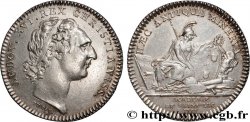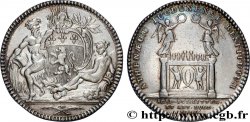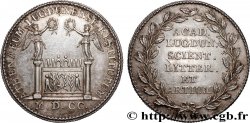fjt_946156 - ACADÉMIES ET SOCIÉTÉS SAVANTES Académie royale d’Architecture n.d.
60.00 €
Menge
In den Warenkorb

Type : Académie royale d’Architecture
Datum: n.d.
Metall : Silber
Durchmesser : 31 mm
Stempelstellung : 6 h.
Gewicht : 7,63 g.
Seltenheitsgrad : R1
N° im Nachschlagewerk :
Vorderseite
Titulatur der Vorderseite LUDOV. XVI. REX. CHRISTIANISS.
Beschreibung Vorderseite Buste à gauche de Louis XVI signé J.P.DROZ.F. [n° 380].
Übersetzung der Vorderseite Louis XVI, roi très chrétien.
Rückseite
Titulatur der Rückseite ACADÉMIE ROYALE D'ARCHITECTURE EN TROIS LIGNES DANS LE CHAMP.
Kommentare
Fondée en 1671, à l'initiative de Colbert, l'Académie d'architecture est la dernière académie royale créée. Elle siège d'abord au Louvre, puis, à partir de 1692, au Palais-Royal. Elle réunit les plus qualifiés des architectes du Roi, qui ont pour missions de jouer un rôle de conseil et d'expertise auprès de l'administration des bâtiments, de définir les règles de la "belle architecture", et de former un séminaire de jeunes architectes. En 1676, le titre d'architecte du Roi se trouve réservé aux seuls membres de l'Académie, ce qui achève de distinguer les architectes des maîtres-maçons. Quelques grands noms : Bruand, Le Pautre, Le Vau.
Founded in 1671, at the initiative of Colbert, the Academy of Architecture was the last royal academy to be created. It was first located in the Louvre, then, from 1692, in the Palais-Royal. It brought together the most qualified of the King's architects, whose missions were to play an advisory and expert role to the building administration, to define the rules of \\\"beautiful architecture\\\", and to train a seminary of young architects. In 1676, the title of architect of the King was reserved only for members of the Academy, which finally distinguished architects from master masons. Some great names: Bruand, Le Pautre, Le Vau
Founded in 1671, at the initiative of Colbert, the Academy of Architecture was the last royal academy to be created. It was first located in the Louvre, then, from 1692, in the Palais-Royal. It brought together the most qualified of the King's architects, whose missions were to play an advisory and expert role to the building administration, to define the rules of \\\"beautiful architecture\\\", and to train a seminary of young architects. In 1676, the title of architect of the King was reserved only for members of the Academy, which finally distinguished architects from master masons. Some great names: Bruand, Le Pautre, Le Vau








 Berichten über einen Fehler
Berichten über einen Fehler Die Seite drucken
Die Seite drucken Teilen meiner Auswahl
Teilen meiner Auswahl Stellen Sie eine Frage
Stellen Sie eine Frage Einlieferung/Verkauf
Einlieferung/Verkauf
 Details
Details















